Numerical Determination of Anisotropic Permeability for Unconsolidated Hydrate Reservoir: A DEM–CFD Coupling Method
Abstract
1. Introduction
2. Materials and Methods
3. DEM–CFD Coupling Simulation
3.1. Reservoir Sediment Modeling According to Geological Origins
3.2. Geometric Model of Pore Space
3.3. Pore-Scale Seepage Simulation
4. Case Studies
4.1. Homogeneous Model Consisting of Identically Sized Spherical Particles
4.2. Heterogeneous Model Consisting of Plate-Shaped, Elongated, and Spherical Particles
5. Conclusions
- (1)
- According to the physical process of sedimentation, a reservoir sediments-modeling method is developed based on the DEM framework, which has the ability to restore the anisotropy of physical properties. An interface program is designed to connect the geometric models of DEM and FEM, and pore-scale computational fluid mechanics simulation is conducted to obtain the anisotropic permeability for the hydrate reservoir.
- (2)
- An idealized homogeneous model consisting of identically sized spherical particles are constructed, and the permeability is obtained with DEM–CFD coupling simulation. The analytical, experimental, and numerical results from previous studies exhibit a high level of consistency with this study, which verifies the accuracy and applicability of the proposed method.
- (3)
- With the increase in compaction stress, the permeability anisotropy exhibited a rapid initial increase, followed by a sustained stabilization. The primary cause is the rearrangement of sediment particles. The non-spherical particles are driven to align in a predominantly horizontal orientation, thereby enhancing anisotropy. A piecewise mathematical model is developed to accurately predict the evolution of permeability anisotropy with a turning point of 3 MPa.
Author Contributions
Funding
Institutional Review Board Statement
Informed Consent Statement
Data Availability Statement
Acknowledgments
Conflicts of Interest
References
- Song, Y.C.; Yang, L.; Zhao, J.F.; Liu, W.G.; Yang, M.J.; Li, Y.H.; Liu, Y.; Li, Q.P. The status of natural gas hydrate research in China: A review. Renew. Sustain. Energy Rev. 2014, 31, 778–791. [Google Scholar] [CrossRef]
- Dong, K.; Sun, R.; Hochman, G.; Zeng, X.; Li, H.; Jiang, H. Impact of natural gas consumption on CO2 emissions: Panel data evidence from China’s provinces. J. Clean. Prod. 2017, 162, 400–410. [Google Scholar] [CrossRef]
- Aydin, G. Forecasting Natural Gas Production Using Various Regression Models. Pet. Sci. Technol. 2015, 33, 1486–1492. [Google Scholar] [CrossRef]
- Wu, L.C.; Zhu, Y.S.; Liu, Y.X.; Zhou, Z.H.; He, D.B. Development techniques of multi-layer tight gas reservoirs in mining rights overlapping blocks: A case study of the Shenmu gas field, Ordos Basin, NW China. Pet. Explor. Dev. 2015, 42, 904–912. [Google Scholar] [CrossRef]
- Shagapov, V.S.; Chiglintseva, A.S.; Rusinov, A.A. Theoretical modeling of gas extraction from a partially gas-saturated porous gas-hydrate reservoir with respect to thermal interactions with surrounding rocks. Theor. Found. Chem. Eng. 2016, 50, 449–458. [Google Scholar] [CrossRef]
- Li, Z.F.; Han, J. Environmental safety and low velocity of the development of submarine natural gas hydrate with examples of test production in South China Sea. Environ. Sci. Pollut. Res. 2021, 28, 6259–6265. [Google Scholar] [CrossRef]
- Chong, Z.R.; Yang, S.H.B.; Babu, P.; Linga, P.; Li, X.S. Review of natural gas hydrates as an energy resource: Prospects and challenges. Appl. Energy 2016, 162, 1633–1652. [Google Scholar] [CrossRef]
- Kvenvolden, K.A. Gas hydratesgeological perspective and global change. Rev. Geophys. 1993, 31, 173–187. [Google Scholar] [CrossRef]
- Sloan, E.D. Fundamental principles and applications of natural gas hydrates. Nature 2003, 426, 353–359. [Google Scholar] [CrossRef]
- Boswell, R.; Collett, T.S. Current perspectives on gas hydrate resources. Energy Environ. Sci. 2011, 4, 1206–1215. [Google Scholar] [CrossRef]
- Kurihara, M.; Sato, A.; Funatsu, K.; Ouchi, H.; Yamamoto, K.; Numasawa, M.; Ebinuma, T.; Narita, H.; Masuda, Y.; Dallimore, S.R.; et al. Analysis of Production Data for 2007/2008 Mallik Gas Hydrate Production Tests in Canada. In Proceedings of the International Oil and Gas Conference and Exhibition in China, Beijing, China, 8–10 June 2010; p. SPE–132155-MS. [Google Scholar]
- Li, J.-F.; Ye, J.-L.; Qin, X.-W.; Qiu, H.-J.; Wu, N.-Y.; Lu, H.-L.; Xie, W.-W.; Lu, J.-A.; Peng, F.; Xu, Z.-Q.; et al. The first offshore natural gas hydrate production test in South China Sea. China Geol. 2018, 1, 5–16. [Google Scholar] [CrossRef]
- Han, Z.; Zhang, L.; Zhou, J.; Pan, Z.; Wang, S.; Li, R. Effects of hydrate occurring mechanisms and saturation on the mechanical properties of hydrate-bearing sediments: Numerical study based on simplified DEM simulation. J. Nat. Gas Sci. Eng. 2022, 108, 104804. [Google Scholar] [CrossRef]
- Zangqa, S.; Saffou, E.; Gholami, R.; Zimmermann, U.; Raza, A.; Manzi, M.S.D.; Durrheim, R. Hydraulic fracturing potential of tight gas reservoirs: A case study from a gas field in the Bredasdorp Basin, South Africa. Gas Sci. Eng. 2024, 128, 205364. [Google Scholar] [CrossRef]
- Bosikov, I.I.; Klyuev, R.V.; Mayer, A.V. Comprehensive assessment of hydraulic fracturing technology efficiency for well construction during hydrocarbon production. J. Min. Inst. 2022, 258, 1018–1025. [Google Scholar] [CrossRef]
- Yan, P.; Luan, H.J.; Jiang, Y.J.; Liang, W.; Liu, M.K.; Chen, H.B. Influence of depressurization mode on natural gas hydrate production characteristics: One-dimensional experimental study. Geoenergy Sci. Eng. 2024, 234, 212671. [Google Scholar] [CrossRef]
- Yu, Q.; Tang, H.; Li, C.; Chen, Z.; Zhang, K.; Yu, Y.; Liang, S. Numerical Simulation of Natural-Gas-Hydrate Decomposition in Process of Heat-Injection Production. Processes 2023, 11, 2349. [Google Scholar] [CrossRef]
- Mahabadi, N.; Dai, S.; Seol, Y.; Jang, J. Impact of hydrate saturation on water permeability in hydrate-bearing sediments. J. Pet. Sci. Eng. 2019, 174, 696–703. [Google Scholar] [CrossRef]
- Delli, M.L.; Grozic, J.L.H. Experimental determination of permeability of porous media in the presence of gas hydrates. J. Pet. Sci. Eng. 2014, 120, 1–9. [Google Scholar] [CrossRef]
- Ruppel, C.D.; Kessler, J.D. The interaction of climate change and methane hydrates. Rev. Geophys. 2017, 55, 126–168. [Google Scholar] [CrossRef]
- Torres, M.E.; Trehu, A.M.; Cespedes, N.; Kastner, M.; Wortmann, U.G.; Kim, J.H.; Long, P.; Malinverno, A.; Pohlman, J.W.; Riedel, M.; et al. Methane hydrate formation in turbidite sediments of northern Cascadia, IODP Expedition 311. Earth Planet. Sci. Lett. 2008, 271, 170–180. [Google Scholar] [CrossRef]
- Stewart, M.L.; Ward, A.L.; Rector, D.R. A study of pore geometry effects on anisotropy in hydraulic permeability using the lattice-Boltzmann method. Adv. Water Resour. 2006, 29, 1328–1340. [Google Scholar] [CrossRef]
- Li, R.R.; Zhang, L.Q.; Zhou, J.; Han, Z.H.; Pan, Z.J.; Schüttrumpf, H. Investigation on permeability anisotropy in unconsolidated hydrate-bearing sediments based on pore-scale numerical simulation: Effect of mineral particle shape and pore-filling. Energy 2023, 267, 126456. [Google Scholar] [CrossRef]
- Li, R.R.; Zhang, L.Q.; Han, Z.H.; Zhou, J.; Wang, S.; Schuettrumpf, H. Effect of interlayer mixed zone and effective stress on permeability anisotropy of NGH turbidite reservoir. Energy 2023, 284, 129172. [Google Scholar] [CrossRef]
- Zhang, Z.; Liu, L.L.; Ning, F.L.; Liu, Z.C.; Sun, J.Y.; Li, X.D.; Sun, J.X.; Hyodo, M.; Liu, C.L. Effect of stress on permeability of clay silty cores recovered from the Shenhu hydrate area of the South China Sea. J. Nat. Gas Sci. Eng. 2022, 99, 104421. [Google Scholar] [CrossRef]
- Yoneda, J.; Oshima, M.; Kida, M.; Kato, A.; Konno, Y.; Jin, Y.; Jang, J.B.; Waite, W.F.; Kumar, P.; Tenma, N. Permeability variation and anisotropy of gas hydrate-bearing pressure-core sediments recovered from the Krishna-Godavari Basin, offshore India. Mar. Pet. Geol. 2019, 108, 524–536. [Google Scholar] [CrossRef]
- Hu, C.; Jia, Y.G.; Duan, Z.B. The influence of inhomogeneous hydrate formation on permeability anisotropy of porous media. Geo-Mar. Lett. 2021, 41, 10. [Google Scholar] [CrossRef]
- Rudyk, S.; Al-Musalhi, M.; Taura, U.; Spirov, P. Matching of Water Breakthroughs in a Low-Resistivity Oil Reservoir Using Permeability Anisotropy. Appl. Sci. 2024, 14, 4618. [Google Scholar] [CrossRef]
- Ren, X.W.; Guo, Z.Y.; Ning, F.L.; Ma, S.Z. Permeability of hydrate-bearing sediments. Earth-Sci. Rev. 2020, 202, 103100. [Google Scholar] [CrossRef]
- Masuda, Y.; Naganawa, S.; Ando, S.; Sato, K. Numerical calculation of gas production performance from reservoirs containing natural gas hydrates. SPE J. 1997, 29, 38291. [Google Scholar]
- Wang, Q.; Chen, X.; Zhang, L.; Wang, Z.; Wang, D.; Dai, S. An Analytical Model for the Permeability in Hydrate-Bearing Sediments Considering the Dynamic Evolution of Hydrate Saturation and Pore Morphology. Geophys. Res. Lett. 2021, 48, e2021GL093397. [Google Scholar] [CrossRef]
- Kleinberg, R.L.; Flaum, C.; Griffin, D.D.; Brewer, P.G.; Malby, G.E.; Peltzer, E.T.; Yesinowski, J.P. Deep sea NMR: Methane hydrate growth habit in porous media and its relationship to hydraulic permeability, deposit accumulation, and submarine slope stability. J. Geophys. Res. Solid Earth 2003, 108, 2508. [Google Scholar] [CrossRef]
- Zhang, Z.; Liu, L.L.; Lu, W.J.; Liu, C.L.; Ning, F.L.; Dai, S. Permeability of hydrate-bearing fine-grained sediments: Research status, challenges and perspectives. Earth-Sci. Rev. 2023, 244, 104517. [Google Scholar] [CrossRef]
- Seol, Y.; Kneafsey, T.J. Methane hydrate induced permeability modification for multiphase flow in unsaturated porous media. J. Geophys. Res.-Solid Earth 2011, 116, B08102. [Google Scholar] [CrossRef]
- Konno, Y.; Yoneda, J.; Egawa, K.; Ito, T.; Jin, Y.; Kida, M.; Suzuki, K.; Fujii, T.; Nagao, J. Permeability of sediment cores from methane hydrate deposit in the Eastern Nankai Trough. Mar. Pet. Geol. 2015, 66, 487–495. [Google Scholar] [CrossRef]
- Lagioia, R.; Sanzeni, A.; Colleselli, F. Air, water and vacuum pluviation of sand specimens for the triaxial apparatus. Soils Found. 2006, 46, 61–67. [Google Scholar] [CrossRef]
- Deng, P.; Zhu, J.T. Anisotropy of Unsaturated Layered Soils: Impact of Layer Composition and Domain Size. Soil Sci. Soc. Am. J. 2015, 79, 487–494. [Google Scholar] [CrossRef]
- Wang, M.; Pan, N. Numerical analyses of effective dielectric constant of multiphase microporous media. J. Appl. Phys. 2007, 101, 114102. [Google Scholar] [CrossRef]
- Kou, X.; Li, X.-S.; Wang, Y.; Liu, J.-W.; Chen, Z.-Y. Heterogeneity of hydrate-bearing sediments: Definition and effects on fluid flow properties. Energy 2021, 229, 120736. [Google Scholar] [CrossRef]
- Garcia, X.; Akanji, L.T.; Blunt, M.J.; Matthai, S.K.; Latham, J.P. Numerical study of the effects of particle shape and polydispersity on permeability. Phys. Rev. E 2009, 80, 021304. [Google Scholar] [CrossRef]
- Zhang, Y.C.; Li, C.F.; Ma, J.S.; Liu, L.L.; Golsanami, N.; Wan, Y.Z.; Liu, C.L. Investigating the effective permeability evolution as a function of hydrate saturation in the hydrate-bearing sands using a kinetic-theory-based pore network model. Comput. Geotech. 2022, 150, 104930. [Google Scholar] [CrossRef]
- Mahabadi, N.; Dai, S.; Seol, Y.; Yun, T.S.; Jang, J. The water retention curve and relative permeability for gas production from hydrate-bearing sediments: Pore-network model simulation. Geochem. Geophys. Geosyst. 2016, 17, 3099–3110. [Google Scholar] [CrossRef]
- Wang, J.Q.; Zhao, J.F.; Zhang, Y.; Wang, D.Y.; Li, Y.H.; Song, Y.C. Analysis of the effect of particle size on permeability in hydrate-bearing porous media using pore network models combined with CT. Fuel 2016, 163, 34–40. [Google Scholar] [CrossRef]
- Hou, J.; Ji, Y.K.; Zhou, K.; Liu, Y.G.; Wei, B. Effect of hydrate on permeability in porous media: Pore-scale micro-simulation. Int. J. Heat Mass Transf. 2018, 126, 416–424. [Google Scholar] [CrossRef]
- Kossel, E.; Deusner, C.; Bigalke, N.; Haeckel, M. The Dependence of Water Permeability in Quartz Sand on Gas Hydrate Saturation in the Pore Space. J. Geophys. Res.-Solid Earth 2018, 123, 1235–1251. [Google Scholar] [CrossRef]
- Fang, F.; Ning, F.L.; Ou, W.J.; Wang, D.D.; Zhang, Z.; Yu, Y.J.; Lu, H.F.; Wu, J.Y.; Vlugt, T.J.H. The dynamic behavior of gas hydrate dissociation by heating in tight sandy reservoirs: A molecular dynamics simulation study. Fuel 2019, 258, 116106. [Google Scholar] [CrossRef]
- Markauskas, D.; Kruggel-Emden, H.; Sivanesapillai, R.; Steeb, H. Comparative study on mesh-based and mesh-less coupled CFD-DEM methods to model particle-laden flow. Powder Technol. 2017, 305, 78–88. [Google Scholar] [CrossRef]
- Talele, V.; Vadaje, Y. An ANN-based data-predictive approach for comparative study between CFD finite difference and finite volume method. Int. J. Mod. Phys. C 2022, 33, 1–20. [Google Scholar] [CrossRef]
- Jeong, W.; Seong, J. Comparison of effects on technical variances of computational fluid dynamics (CFD) software based on finite element and finite volume methods. Int. J. Mech. Sci. 2014, 78, 19–26. [Google Scholar] [CrossRef]
- Oelschlager, K. Simulation of the solution of a viscous porous medium equation by a particle method. SIAM J. Numer. Anal. 2002, 40, 1716–1762. [Google Scholar] [CrossRef]
- Portella, G.; Polupanow, T.; Zocher, F.; Boytsov, D.A.; Pohl, P.; Diederichsen, U.; de Groot, B.L. Design of Peptide-Membrane Interactions to Modulate Single-File Water Transport through Modified Gramicidin Channels. Biophys. J. 2012, 103, 1698–1705. [Google Scholar] [CrossRef] [PubMed][Green Version]
- Cundall, P.A. A computer model for simulating progressive, large-scale movements in block rock systems. In Proceedings of the Symposium of the International Society for Rock Mechanics, Society for Rock Mechanics (ISRM), Nancy, France, 4–6 October 1971; Volume 1(II-B). [Google Scholar]
- Hart, R.; Cundall, P.A.; Lemos, J. Formulation of a three-dimensional distinct element model—Part II. Mechanical calculations for motion and interaction of a system composed of many polyhedral blocks. Int. J. Rock Mech. Min. Sci. Geomech. Abstr. 1988, 25, 117–125. [Google Scholar] [CrossRef]
- Blott, S.J.; Pye, K. Particle shape: A review and new methods of characterization and classification. Sedimentology 2008, 55, 31–63. [Google Scholar] [CrossRef]
- Liang, R.; Schruff, T.; Jia, X.D.; Schuttrumpf, H.; Frings, R.M. Validation of a stochastic digital packing algorithm for porosity prediction in fluvial gravel deposits. Sediment. Geol. 2015, 329, 18–27. [Google Scholar] [CrossRef]
- Cundall, P.A.; Strack, O.D.L. A discrete numerical model for granular assemblies. Géotechnique 1979, 29, 47–65. [Google Scholar] [CrossRef]
- Jin, G.; Torres-Verdin, C.; Lan, C. Pore-Level Study of Grain-Shape Effects on Petrophysical Properties of Porous Media. In Proceedings of the SPWLA 50th Annual Logging Symposium, The Woodlands, TX, USA, 21–24 June 2009. SPWLA–2009-62136. [Google Scholar]
- Zhang, M.; Ye, G.; Breugel, K.V. Microstructure-based modeling of permeability of cementitious materials using multiple-relaxation-time lattice Boltzmann method. Comput. Mater. Sci. 2013, 68, 142–151. [Google Scholar] [CrossRef]
- Lin, J.; Chen, H. Lattice Boltzmann simulation of fluid flow through random packing beds of Platonic particles: Effect of particle characteristics. Particuology 2019, 47, 41–53. [Google Scholar] [CrossRef]
- Sangani, A.S.; Acrivos, A. Slow flow through a periodic array of spheres. Int. J. Multiph. Flow 1982, 8, 343–360. [Google Scholar] [CrossRef]
- Maier, R.S.; Kroll, D.M.; Davis, H.T.; Bernard, R.S. Simulation of flow in bidisperse sphere packings. J. Colloid Interface Sci. 1999, 217, 341–347. [Google Scholar] [CrossRef]
- Prasad, M.K.; Bucha, T. Magnetohydrodynamic creeping flow around a weakly permeable spherical particle in cell models. Pramana 2020, 94, 24. [Google Scholar] [CrossRef]
- Shi, S.; Chen, X.; Ma, J.; Sun, Y.; Sun, C. Natural Gas Hydrate Reservoir Classification and Characterization in the Well W19 of Shenhu Sea Area, northern South China Sea. Spec. Oil Gas Reserv. 2019, 26, 24–29. [Google Scholar] [CrossRef]
- Lyu, X.; Li, Q.; Ge, Y.; Zhu, J.; Zhou, S.; Fu, Q. Fundamental characteristics of gas hydrate-bearing sediments in the Shenhu area, South China Sea. Front. Energy 2021, 15, 367–373. [Google Scholar] [CrossRef]
- Guo, X.S.; Nian, T.K.; Zhao, W.; Gu, Z.D.; Liu, C.P.; Liu, X.L.; Jia, Y.G. Centrifuge experiment on the penetration test for evaluating undrained strength of deep-sea surface soils. Int. J. Min. Sci. Technol. 2022, 32, 363–373. [Google Scholar] [CrossRef]
- Dai, S.; Kim, J.; Xu, Y.; Waite, W.F.; Jang, J.; Yoneda, J.; Collett, T.S.; Kumar, P. Permeability anisotropy and relative permeability in sediments from the National Gas Hydrate Program Expedition 02, offshore India. Mar. Pet. Geol. 2019, 108, 705–713. [Google Scholar] [CrossRef]
- Mao, P.X.; Sun, J.X.; Ning, F.L.; Hu, G.W.; Wan, Y.Z.; Cao, X.X.; Wu, N.Y. Effect of permeability anisotropy on depressurization-induced gas production from hydrate reservoirs in the South China Sea. Energy Sci. Eng. 2020, 8, 2690–2707. [Google Scholar] [CrossRef]

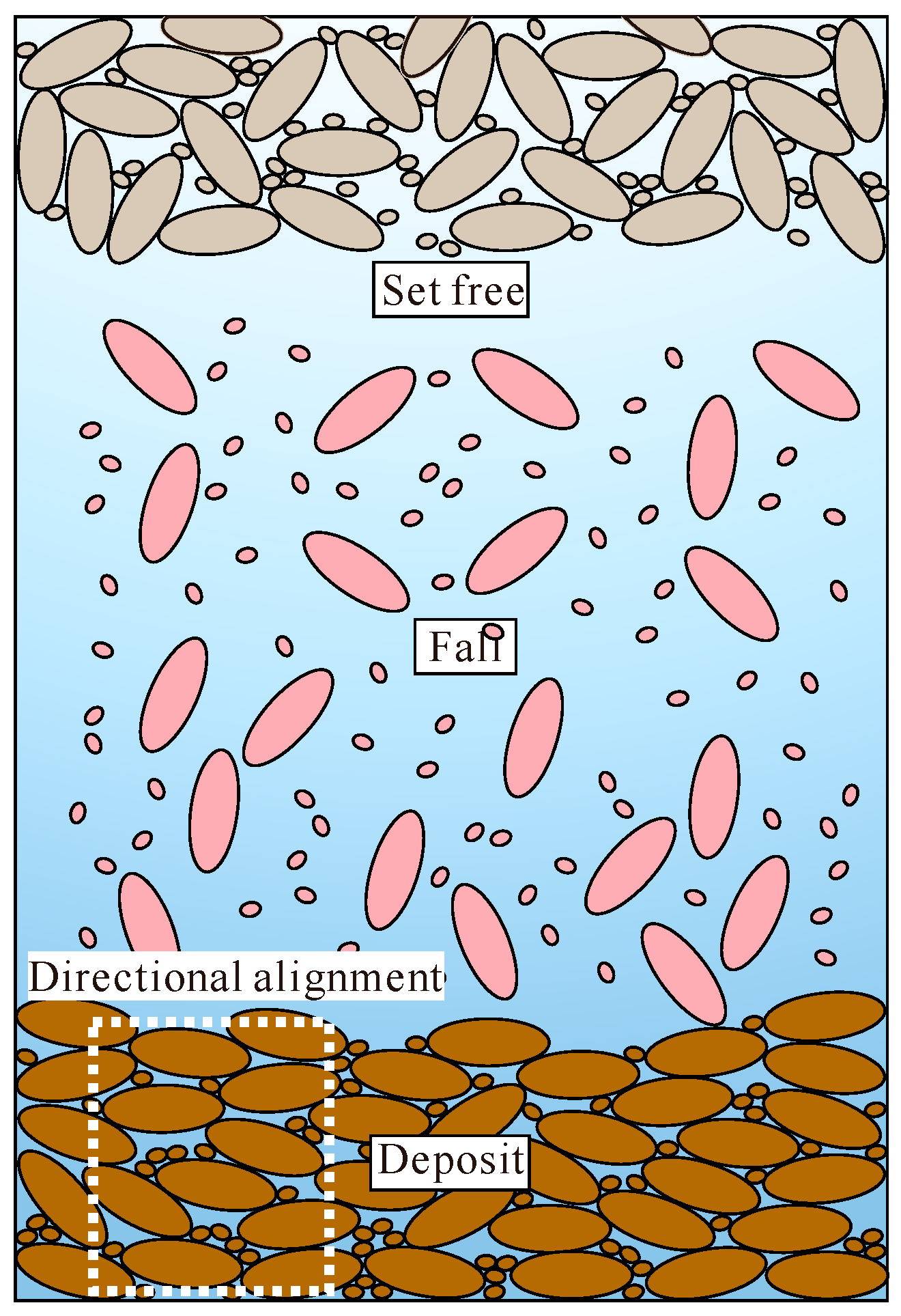

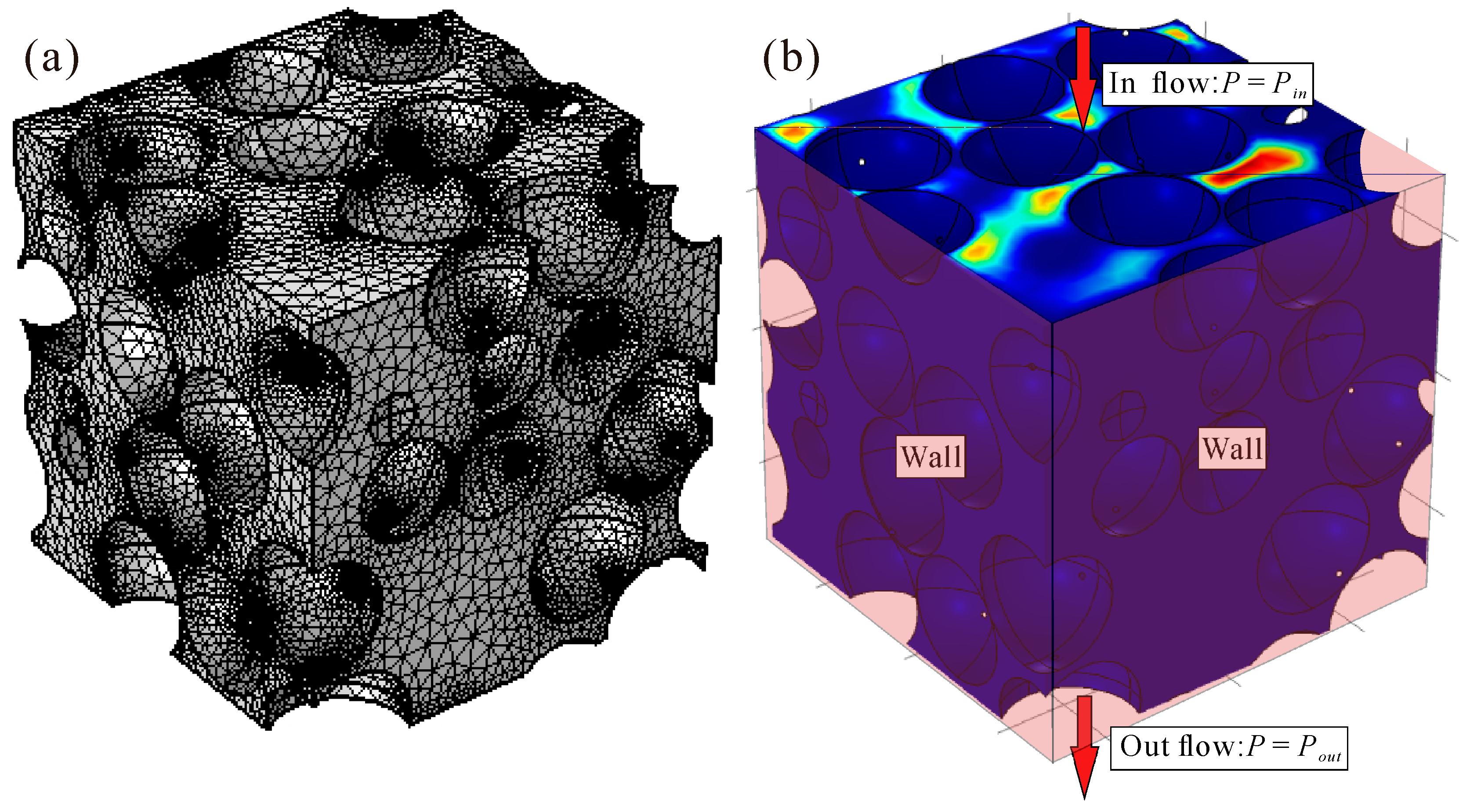
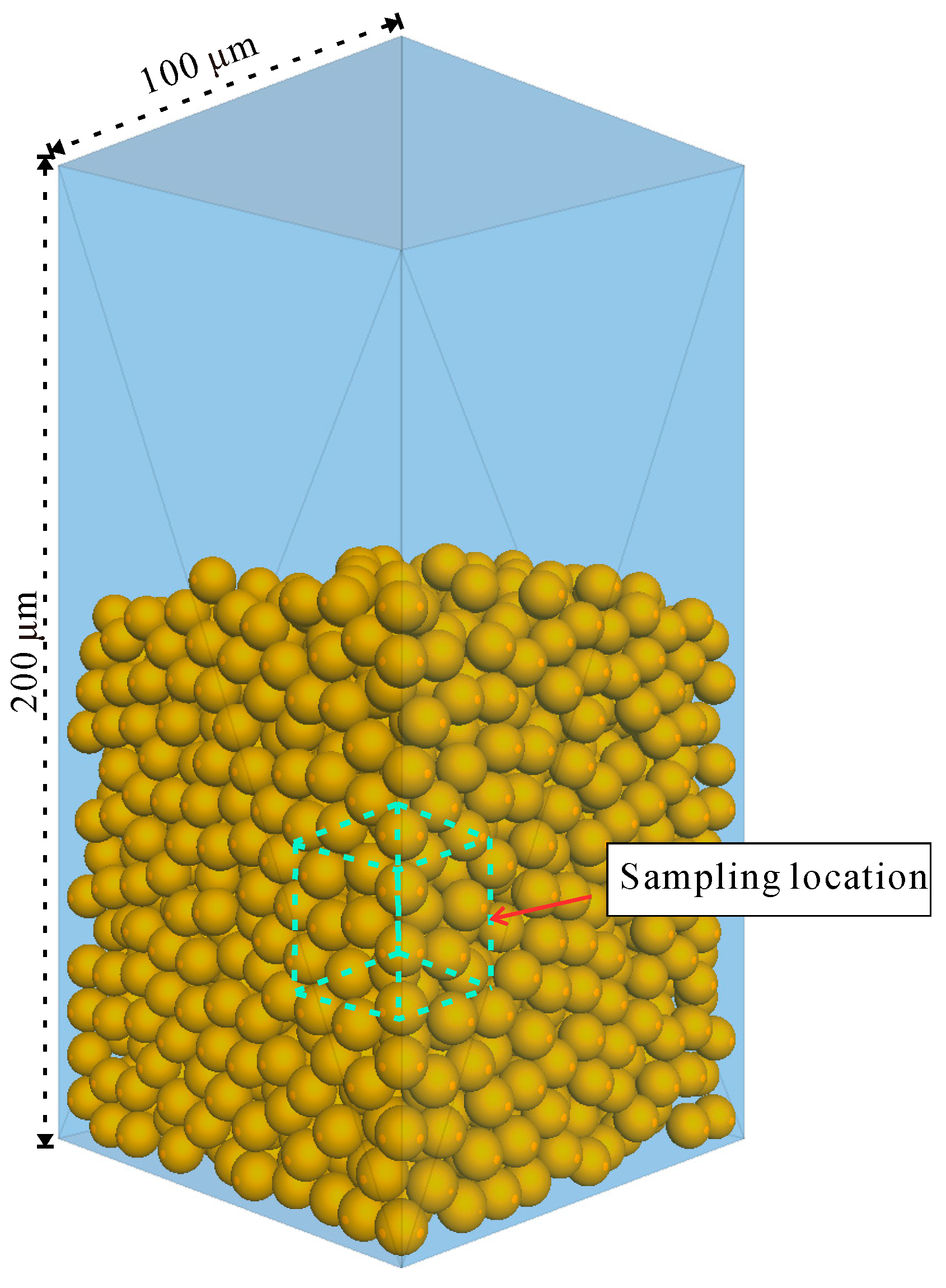
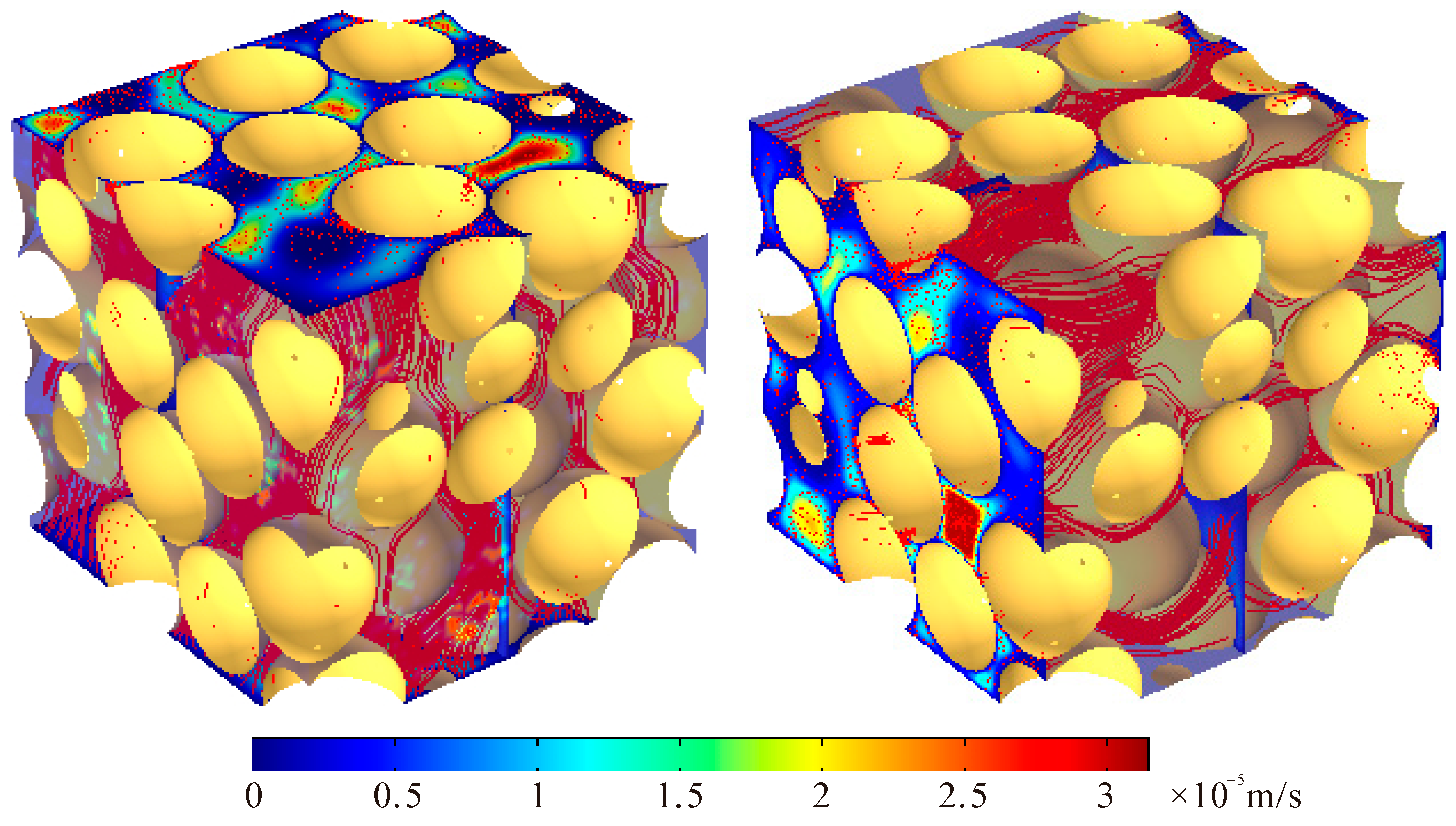
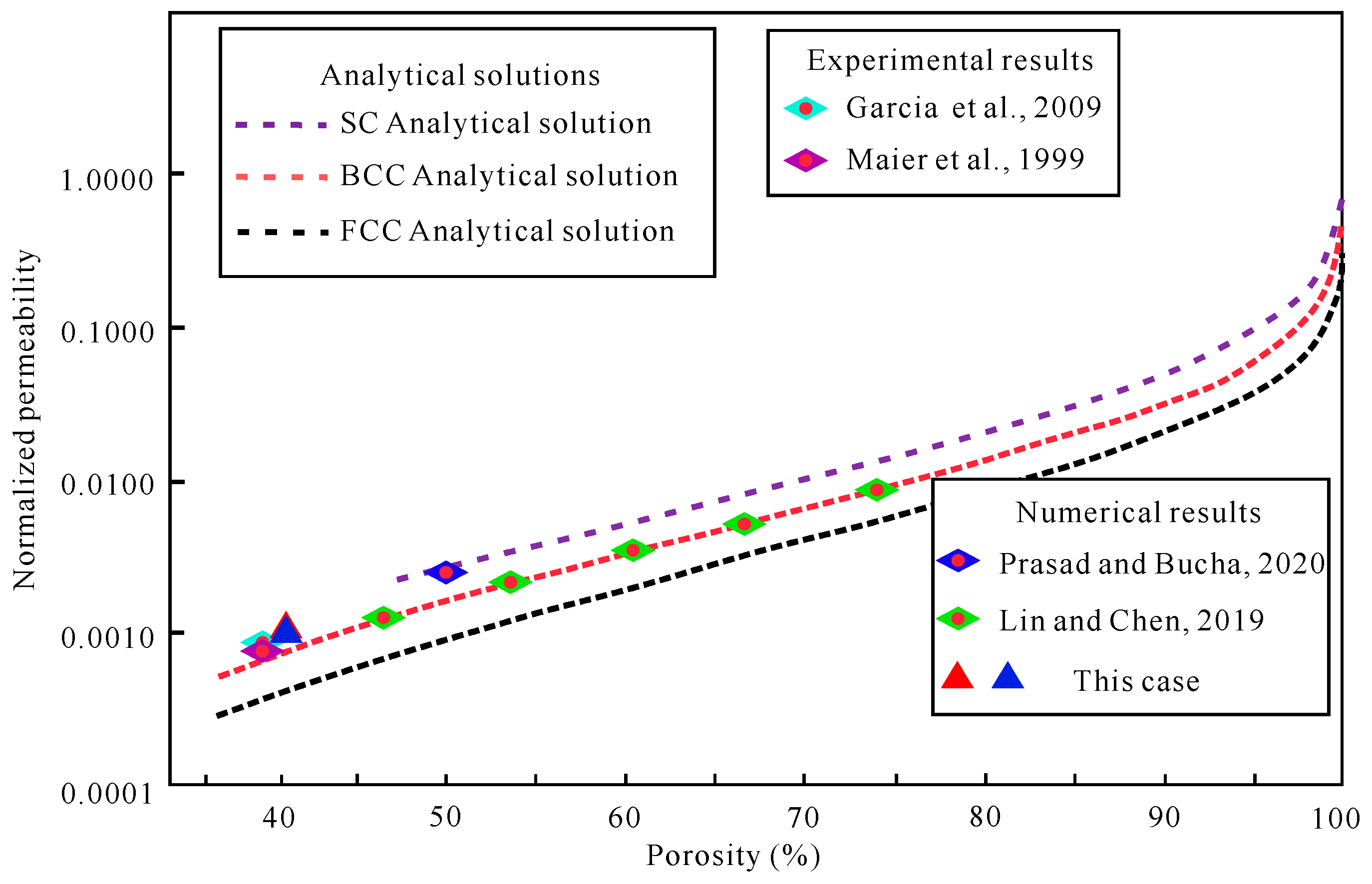
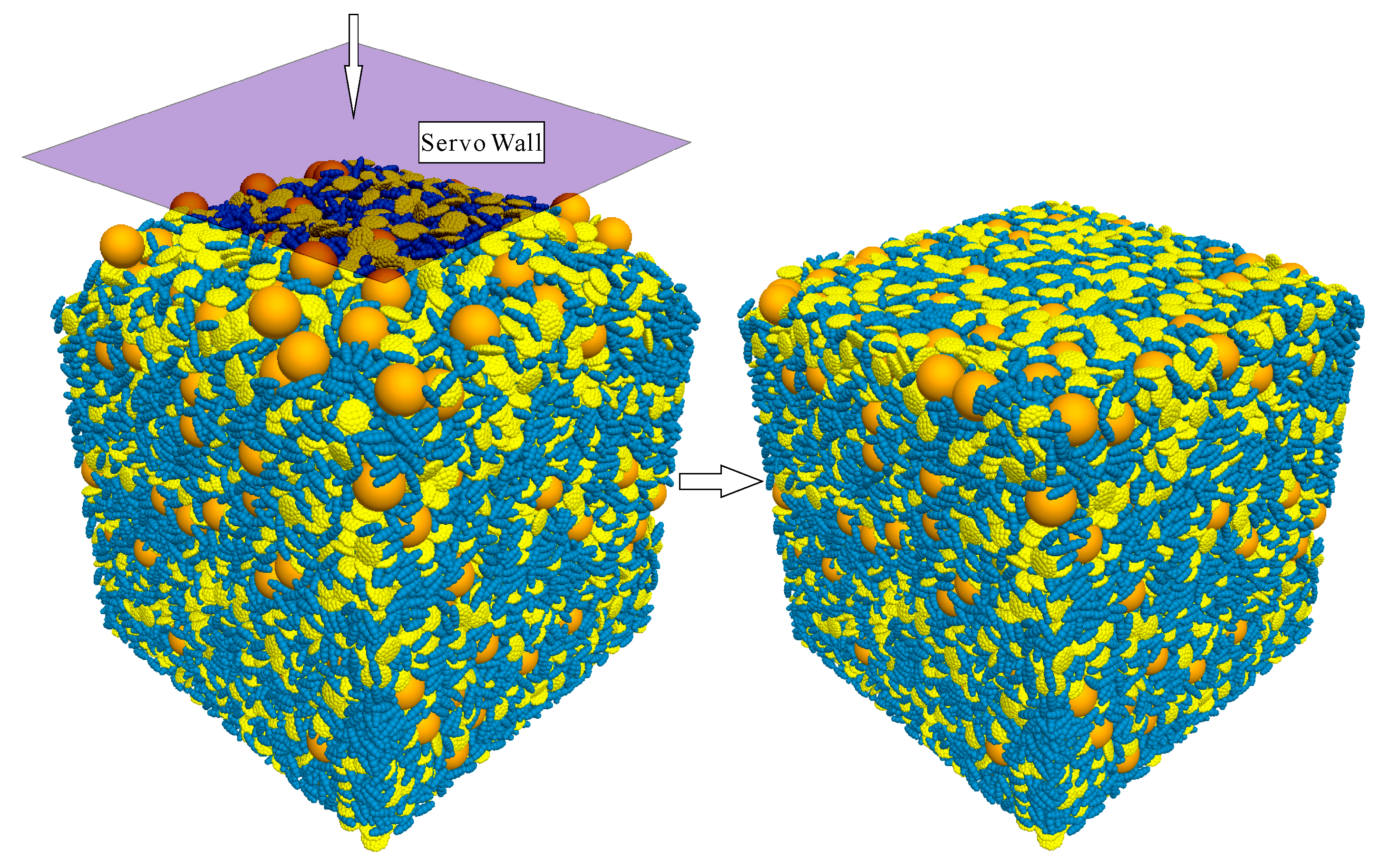
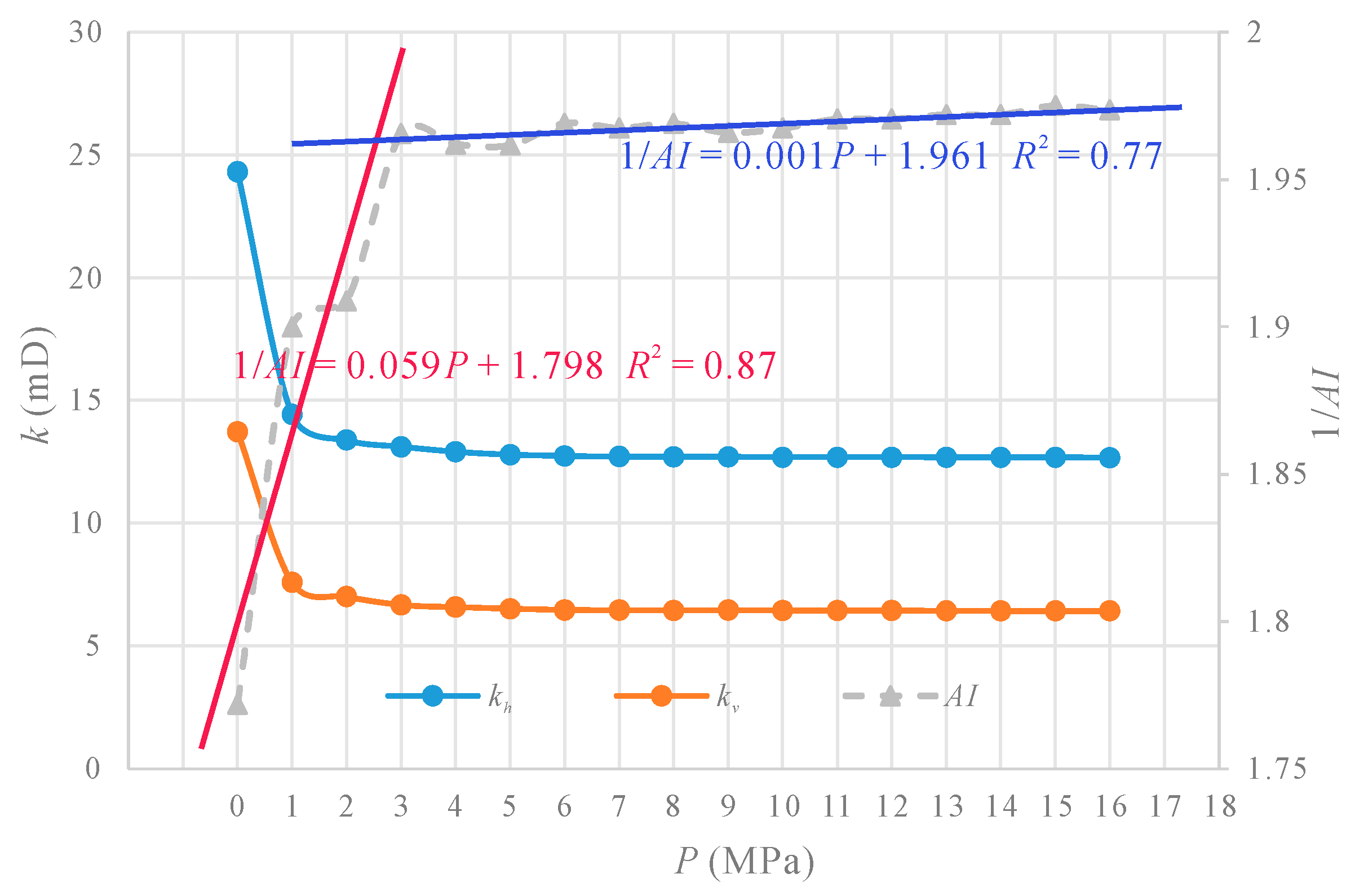

| Parameter | Value |
|---|---|
| Density (kg/m3) | 1000 |
| Dynamic viscosity (Pa·s) | 0.001 |
| L (μm) | 30 |
| Pin (Pa) | 1 |
| Pout (Pa) | 0 |
Disclaimer/Publisher’s Note: The statements, opinions and data contained in all publications are solely those of the individual author(s) and contributor(s) and not of MDPI and/or the editor(s). MDPI and/or the editor(s) disclaim responsibility for any injury to people or property resulting from any ideas, methods, instructions or products referred to in the content. |
© 2024 by the authors. Licensee MDPI, Basel, Switzerland. This article is an open access article distributed under the terms and conditions of the Creative Commons Attribution (CC BY) license (https://creativecommons.org/licenses/by/4.0/).
Share and Cite
Li, R.; Han, Z.; Zhang, L.; Zhou, J.; Wang, S.; Huang, F. Numerical Determination of Anisotropic Permeability for Unconsolidated Hydrate Reservoir: A DEM–CFD Coupling Method. J. Mar. Sci. Eng. 2024, 12, 1447. https://doi.org/10.3390/jmse12081447
Li R, Han Z, Zhang L, Zhou J, Wang S, Huang F. Numerical Determination of Anisotropic Permeability for Unconsolidated Hydrate Reservoir: A DEM–CFD Coupling Method. Journal of Marine Science and Engineering. 2024; 12(8):1447. https://doi.org/10.3390/jmse12081447
Chicago/Turabian StyleLi, Ruirui, Zhenhua Han, Luqing Zhang, Jian Zhou, Song Wang, and Fuyou Huang. 2024. "Numerical Determination of Anisotropic Permeability for Unconsolidated Hydrate Reservoir: A DEM–CFD Coupling Method" Journal of Marine Science and Engineering 12, no. 8: 1447. https://doi.org/10.3390/jmse12081447
APA StyleLi, R., Han, Z., Zhang, L., Zhou, J., Wang, S., & Huang, F. (2024). Numerical Determination of Anisotropic Permeability for Unconsolidated Hydrate Reservoir: A DEM–CFD Coupling Method. Journal of Marine Science and Engineering, 12(8), 1447. https://doi.org/10.3390/jmse12081447





